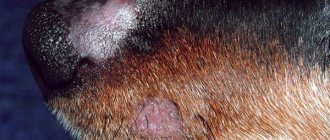In addition to adenovirus, the group of diseases called “kennel cough” includes canine bordetellosis. Its main danger is its long latent course, which often results in mass infection when kept in crowded conditions.
No less problematic is the absence of specific symptoms. The infection is difficult to distinguish from similar pathologies of the respiratory tract without laboratory diagnosis. Therefore, at the first signs of discomfort, it is recommended to contact a veterinarian as soon as possible.
Definition of bordetellosis
The causative agent of the infection is the bacterium Bordetella bronchiseptica, which causes paroxysmal coughing in dogs. It affects the upper and lower respiratory tract, weakening the protection of the cilia of the ciliated epithelium. As a result, toxins penetrate the body, irritating the mucous membranes of the trachea and bronchi.
The patient develops tracheobronchitis. Without timely treatment, inflammation can spread to the lung tissue and lead to pneumonia, fraught with sepsis and acute respiratory failure.
Symptomatic treatment
With timely treatment, recovery occurs within 10–14 days. Bacterial carriage lasts four months. The sick are removed and provided with comfortable conditions. The therapeutic strategy is developing in the following directions:
- antimicrobial therapy;
- symptomatic treatment;
- restorative therapy.
READ How much should a cat and male cat weigh depending on age and breed
A proven treatment for bordetellosis is Doxycycline. Subtitration for sensitivity to antibiotics is indicated if the disease has become widespread, and the use of Doxycycline has not had the desired result. It must be taken into account that the cause of kennel cough may be a complex concomitant infection, so the veterinarian prescribes Gentamicin or fluoroquinolones.
Doxycycline hydrochloride
- Immunomodulators:
- Antiseptic:
Causes of the disease
The bacterium is transmitted by airborne droplets, so the main cause of infection is direct contact with the carrier of the infection or contaminated objects. The danger is posed not only by sick animals, but also by recently recovered animals. Bordetella in their body retains its pathogenicity for up to 3-6 months.
The likelihood of infection increases in winter, since hypothermia negatively affects the immune system. Prolonged stress plays a similar role, so it is very important to monitor not only the living conditions, but also the psychological health of your pet.
Reasons for development
Bordetellosis in cats is caused by a pathogenic bacterial microorganism – Bordetella.
The bacterium is small in size, does not stain by Gram, and is an aerobic microorganism. Coccobacterium bronchiseptica (bordetella) causes a disease such as kennel or kennel cough in dogs. In medical veterinary sources you can find a mention that coccobacteria, which provokes infection of the respiratory tract in cats, is part of the opportunistic microflora of the larynx. Under normal conditions, with normal functioning of the immune system, the bacterium can be sown during bacterial culture or obtained in a smear from the mucous membrane of the throat. But the pathogen does not provoke the disease, so there is no need for special therapy.
There is a theory that coccobacteria is widespread everywhere. An animal that has recovered from infectious tracheobronchitis remains a carrier for a long time. When the body's defenses are reduced during stressful situations, mating, long-term transportation or viral infections, bacteria begin to actively multiply and infect the mucous membranes.
The course of the infection can be acute, subacute or chronic. The period from the moment pathogens penetrate the mucous membranes of the respiratory tract until the appearance of characteristic symptoms varies from one to three weeks.
The first symptoms of acute bordetellosis in a cat are:
- general loss of appetite;
- moderate lethargy;
- the appearance of mucous discharge from the nasal passages;
- sneezing.
During the development of the pathological inflammatory process, a severe cough also joins the general symptoms, especially when the animal makes any movements. Body temperature increases, up to 41 degrees.
Adult cats are more likely to experience the infection without significant symptoms, unlike small kittens. It is in the younger generation that bordetellosis develops quickly, causes serious complications in the form of inflammation of the bronchial tree and lungs, and can also cause death. Small kittens have a productive cough, with a large production of mucous sputum.
The chronic form of bordetellosis is accompanied by rhinitis and inflammation of the conjunctiva. A sick animal develops discharge from the nasal passages and lacrimal duct. Regional submandibular lymph nodes may also increase in size.
Puppies are most susceptible to this disease, that is, dogs up to a year old or a little older, and they suffer it most severely. Infection occurs by airborne droplets, and the “carrier” of the disease can be dogs that once (on average three to six months ago) suffered from bordetellosis.
We invite you to familiarize yourself with Internal Otitis – a severe pathology of the ears in cats
When a healthy dog comes into contact with an infectious dog, infection can easily occur. This cold can await you at any time of the year. In winter - due to decreased immunity due to cold and dampness, and in summer due to longer walks and more frequent contact with other animals.
Any reasons for decreased immunity can increase the risk of infection:
- stress;
- hypothermia;
- drafts.
This disease can also manifest itself during a dog’s pregnancy. If the dog became infected two or three years ago, then the disease might not have started at that time, but began during a time of severe stress for the body - pregnancy, when a complete restructuring of all processes in the body occurs.
Main symptoms
The duration of the incubation period extends to 20 days. The time of onset of symptoms depends on the state of the body’s defenses, and their intensity depends on the form of the disease.
Acute course
The main sign of infection is a dry cough that gets worse with movement. The attacks resemble the gag reflex used to push a foreign object out of the throat.
In addition to cough, symptoms of the disease include:
- severe weakness and loss of appetite;
- giving up games and increasing sleep duration;
- temperature rise above 40 °C;
- sneezing;
- the appearance of mucous discharge from the nose of a transparent or greenish color.
If you notice at least one of the listed symptoms, carefully palpate the submandibular lymph nodes. These organs are part of the immune system responsible for destroying pathogenic microorganisms. When infected, the lymph nodes become inflamed and increase in size as they are filled with lymphocytes.
Course of the chronic form
After some time, the above symptoms subside, and the disease becomes chronic. But a sudden improvement in condition is not a reason for joy. The observed remission is only temporary. The chronic form is practically incurable, so therapy comes down to suppressing symptoms and preventing relapses.
Symptomatic treatment
Infection in cats typically results in sneezing, coughing, runny nose and eyes, and fever. Signs usually last 7-10 days. However, in some cases (especially in small kittens and those with severe stress) infections can be more serious, and can sometimes lead to life-threatening pneumonia, such animals must be euthanized.
The frequency with which B bronchispetica causes disease in cats is not well known. Research has shown that exposure to the bacterium is quite common, especially in areas where animals congregate (such as shelters and some kennels). However, subclinical and mild infections may be common.
How is an infection diagnosed? The diagnosis is made after detection of a bacterial culture in the body (using a specific culture medium) or using PCR.
The disease occurs in the following forms:
- Spicy.
- Permanent.
READ Toxoplasmosis in cats and dogs: symptoms, diagnosis, prevention. Toxoplasmosis in humans
Dogs in the kennel
Acute form
Most often, kittens and puppies are affected during the first 12 weeks of life. The disease is characterized by the following symptoms:
- poor appetite;
- sneeze;
- cough that gets worse when standing up and moving around;
- sputum separation;
- oppression, the baby is constantly lying down;
- temperature rise - 40–41 °C;
- exhaustion.
With improper treatment, bronchitis develops, turning into pneumonia, which often ends in the death of the animal.
Chronic form
It is characterized by the same signs as acute, only they do not appear so clearly. Additional symptoms appear:
- conjunctivitis with copious discharge;
- rhinitis accompanied by nasal discharge;
- lymphadenitis with hypertrophy of local lymph nodes in the submandibular space.
Sick animals are regularly examined and the nose and eyes are cleaned of crusts of dried exudate. Expectorants are used under strict veterinary supervision. All drugs are potent, with many side effects. For individual treatment, the following products are used in the form of drops:
- Immunomodulators:
- Anandin;
- Maxidin;
- Thymogen.
- Anti-inflammatory:
- Naphthyzin;
- Dioxidine;
- Nazivin.
- Antiseptic:
Bordetellosis occurs in acute, fulminant and chronic forms. The incubation period varies: 5-20 days. Its duration depends on many factors. The number of pathogens that have entered, the state of the pet’s immunity, living conditions, the presence of stress factors. Having penetrated inside, microorganisms become attached to the mucous membranes of the respiratory organs.
Vigorous activity causes swelling and hyperemia of the lungs, bronchi and trachea. An increased volume of mucus begins to be produced, and foamy sputum is formed. The accumulation of secretions in the lungs causes inflammation: it can be purulent, catarrhal, or mixed. With severe infection, inflammation of the lymph nodes occurs. The chronic form is accompanied by deformation of the nasal sinuses. In critical cases, bronchopneumonia develops, leading to the death of the animal.
Initially, the animal loses its appetite and becomes lethargic. The puppies have snot and a slight cough. Then the body temperature rises, and a sharp refusal to eat occurs. The pet lies down a lot and tries to move less. In the second phase, a strong cough appears, which tends to increase with movement. The temperature rises to 41 degrees, the submandibular lymph nodes become very swollen.
The listed symptoms of bordetellosis among dogs may not be observed if the animal is mature, strong and robust. In puppies, all processes happen quickly. Without medical help, pulmonary edema soon develops and the baby dies. The chronic form looks like this:
- Conjunctivitis and rhinitis appear.
- There is nasal and eye discharge.
- The lymph nodes are constantly enlarged, especially those under the jaw.
- Cough, poor appetite, apathy.
The animal is breathing heavily, wheezing is heard in the lungs. The worst situation is for pets with pathological narrowing of the trachea syndrome. The number of previously suffered diseases influences. If the dog can be saved, the recovered individual continues to release pathogens. The duration of this period varies, and can be up to 19 weeks.
Whiskered pets get sick a little differently than dogs. The first symptom that appears is heavy breathing. Then profuse nasal discharge is added. Snot accumulates around the nose, dries out, and numerous crusts form. Body temperature increases and the cat's behavior changes. The animal becomes calm and sleepy. Lost appetite.
READ Alaskan Malamute - characteristics of the breed, how it differs from a husky
Then a strong cough appears, the snot becomes thicker, and its volume steadily increases. Sometimes conjunctivitis is associated. Liquid also leaks from the eyes, which sticks the eyelashes together. Mucous discharge turns purulent. The lymph nodes are enlarged and the cat is febrile. Signs increase quickly, within 7-10 days. In kittens, bordetellosis develops at lightning speed, turning into fatal pneumonia.
Diagnostic specifics
Timely diagnosis will help prevent chronic disease. To do this, try to sign up for an examination after detecting the first signs of illness.
The pet will need to undergo an x-ray examination and donate blood. Using an image, the veterinarian will determine the condition of the respiratory tract, and using a blood test will confirm the presence and exact type of pathogen.
Due to a sharp decrease in immunity, in addition to bordetellosis, a sick dog is often diagnosed with adenovirus and distemper. All of these infections require different treatments, so it is very important not to start taking medications until a diagnosis has been made.
Drug therapy
If, according to the results of the study, nothing other than bordetella is found in the body, then the four-legged patient recovers quite quickly. To recover, he is prescribed a course of immunostimulants, and the existing symptoms are eliminated with supportive therapy.
For mixed infections, antibiotics are always used. Animals in serious condition are given oxygen therapy, placing them in a hospital until their respiratory function is stabilized.
Immunostimulants
To stimulate the work of immune cells, vitamins and immunomodulators (Gamavit, Ribotan) are used. These drugs replenish the natural level of essential microelements and prevent the development of secondary pathologies.
Antibiotics
At the time of coughing, antibiotics against Bordetella are ineffective. Pathological changes in the bronchi persist even without a pathogen, so antibiotic therapy makes sense only in the presence of secondary pathologies. On average it takes about a week.
Elimination of symptoms
Mucolytics are used to eliminate dry cough. They thin phlegm, making it easier to remove mucus from the lungs.
Existing inflammation is relieved with anti-inflammatory drugs or glucocorticosteroids. If the dog suffers from bronchospasm and rhinitis, then the list of symptomatic medications is supplemented with bronchodilators, nasal drops or spray.
Keeping a pet and quarantine
During treatment, the pet must be protected from excessive physical activity and stress. Overexcitement increases respiratory failure and can aggravate existing attacks. To make breathing easier during walks, the collar will have to be temporarily replaced with a harness that does not put pressure on the neck.
When feeding naturally, parsley, broccoli and rosehip infusions should be added to the diet. They are rich in ascorbic acid, an essential vitamin that stimulates the production of immune cells.
Remember that for comfortable absorption of most recommended vitamins you need a lot of water. Make sure your pet drinks enough fluids. Change your water bowl at least once a day or purchase a drinking fountain that filters contaminants.
To prevent infection of other pets, the patient will have to be isolated in a separate room. You will have to be careful for 6 months after recovery, avoiding contact with other pets on the street.
Is Bordetella dangerous for people?
Bordetella is dangerous not only for four-legged pets, but also for their owners. A person infected with it becomes ill with whooping cough, a respiratory disease with similar symptoms. People at risk include people with weakened immune systems:
- children under 2 years old;
- HIV-infected;
- pregnant women;
- patients with oncology or other respiratory diseases;
- who have had their spleen removed.
Whooping cough is most severe in newborns, so be sure to prevent any contact of the infected person with children. If you are not vaccinated against this infection, then the probability of infection is almost 75%.
Despite the risks, you will still have to care for a sick dog. To prevent infection, stop any attempts at licking and wash your hands thoroughly after treating your pet with medications.
Bordetellosis in cats
Bordetellosis is an infectious disease caused by the bacterium Bordetella bronchiseptica. Bordetella usually affects the upper respiratory tract and can lead to pneumonia in the animal.
Content
- Causes
- Symptoms
- Diagnosis and treatment
Causes
Not only cats, but also dogs, pigs, and rabbits suffer from bordetellosis. The most important thing is that bordetellosis is a zooanthroponotic disease (that is, transmitted from animal to human). Human infection with this bacterium is quite rare; most cases occur in people with weakened immune systems.
In cats and dogs, the causative agent of bordetellosis is the most common cause of “kennel (kennel) cough.” The route of transmission of the disease is quite simple: Bordetella is excreted in saliva, with discharge from the nose, when an animal sneezes, and can remain in the environment (outside the animal’s body) for up to 10 days. In addition to direct contact and airborne mechanisms of transmission of the disease, there is also an indirect route, when the disease is transmitted through an intermediate object (for example, through bowls or you can bring a bacterium from the street to a domestic cat). This is why bordetellosis is so common in places where animals are overcrowded, in nurseries, apartment buildings, etc.
The bacterium itself is susceptible to conventional disinfectants.
In adult cats, if there are no other respiratory diseases or weakened immunity, the disease is mild. Manifested by mild sneezing, coughing, and minor discharge from the eyes and nose. And all these symptoms disappear in about a week. Adult cats can also be carriers of the disease and still appear completely healthy.
However, in kittens or adult animals with a weakened immune system or under severe stress, bordetellosis is severe and without treatment can lead to pneumonia and subsequent death of the animal.
Often, the course of bordetellosis is complicated by the presence of other respiratory diseases in cats (rhinotracheitis, calicivirosis).
Symptoms
At the onset of the disease, symptoms such as:
- Cough,
- Apathy, lethargy,
- Nasal discharge
- Sneezing,
- Discharge from the eyes
- Increased body temperature
- Lack of appetite,
- Difficulty breathing,
- The lymph nodes in the neck area are enlarged.
Without treatment, the disease continues to progress. Cats develop wheezing in the lungs, a wet cough, it is more difficult for the animal to breathe, there is weight loss, shortness of breath, and visible mucous membranes become bluish from lack of oxygen.
Diagnosis and treatment
To make a diagnosis, you need to go to a veterinary clinic, tell a detailed medical history, and take a PCR test for all respiratory infections in cats. To understand the prognosis and prescribe treatment, you will need a general clinical blood test, a chest x-ray, and possibly other diagnostic methods (determined by a veterinarian based on the examination of the animal).
Depending on the test results and the general condition of the animal, specific therapy is prescribed. If the cat has no appetite, an intravenous catheter is placed and infusion therapy (drip) is performed.
Typically, in cats with uncomplicated infection, symptoms resolve within 2 weeks.
It is worth noting that the disappearance of all symptoms of the disease does not mean complete recovery of the animal. Cats can be infectious to other animals for up to 19 weeks. During this time, you should isolate your pet from other animals. And also have separate bowls, beds, trays and other things with which the cat can come into contact.
There is an effective vaccine against Bordetella. Preventive vaccination is carried out annually. It is especially important to vaccinate animals that are kept in crowded conditions.
When contacting a veterinary clinic at the initial stage of the disease, with timely treatment, the recovery period passes much faster and with less stress for the animal.
The article was prepared by A.V. Goryacheva,
veterinary therapist at MEDVET © 2021 SEC MEDVET
Prevention measures
Prevention of the disease consists of improving the living conditions of the pet and avoiding contact with unfamiliar animals. Remember that the absence of a cough and other symptoms does not guarantee the absence of infection. You should be wary of not only dogs, but also cats - they are also susceptible to infection with Bordetella and can act as carriers.
If your pet participates in exhibitions, is involved in sports, or attends training courses, consult a doctor about the advisability of vaccination. Immunity against the pathogen can be obtained thanks to the Nobivac KS complex vaccine, used to prevent parainfluenza. Its effect is 1 year, so after the specified time the vaccination is repeated.
Canine bordetellosis is very insidious. It skillfully disguises itself as a less dangerous infection and is difficult to diagnose, increasing the likelihood of infecting others.
If you decide to get a new pet and plan to go to a dog kennel, be sure to check the candidate you like with a veterinarian before bringing him home. Timely diagnosis will eliminate infection of your family members and prevent chronic disease.
The article is for informational purposes only. Contact your veterinarian!











